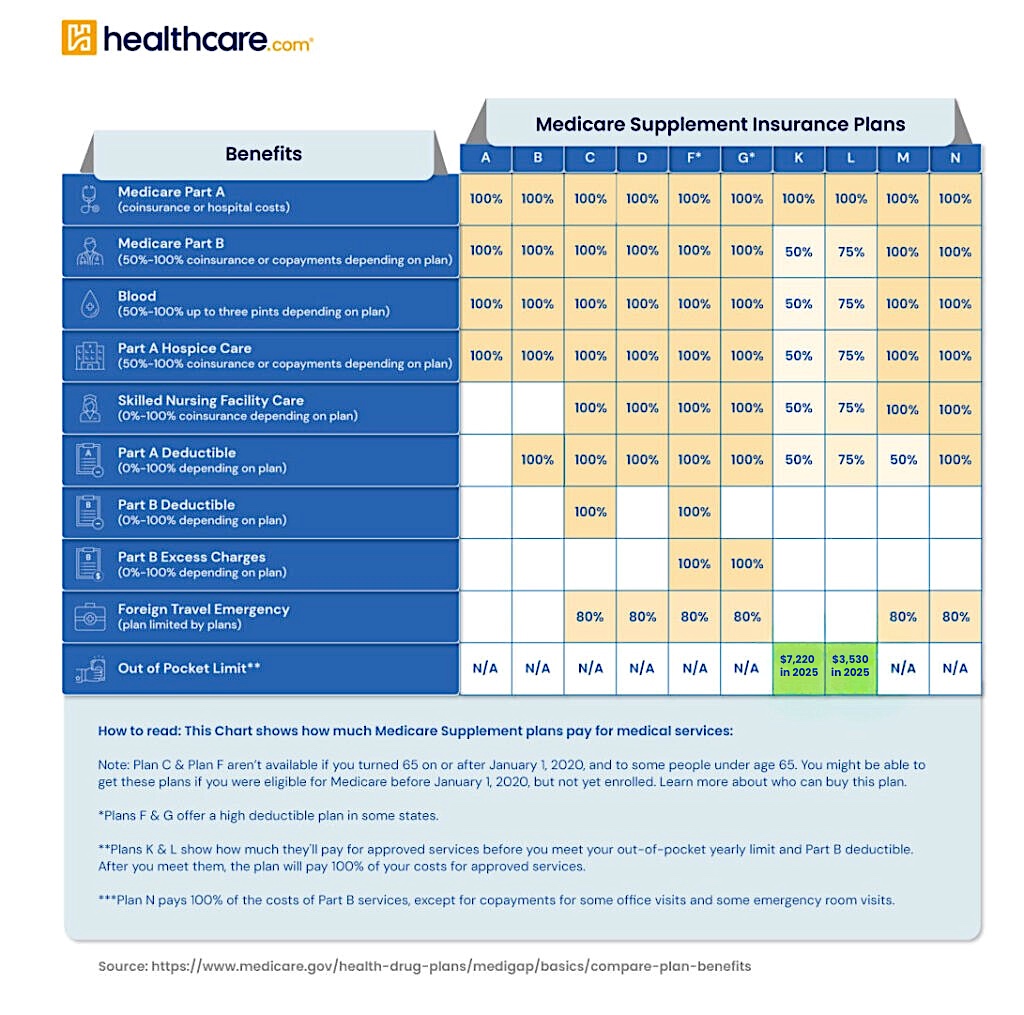Written by Tara Seboldt
HealthCare Writer
We aim to help you make informed healthcare decisions. While this post may contain links to lead generation forms, this won’t influence our writing. We follow strict editorial standards to give you the most accurate and unbiased information.
What You Need to Know
- Medicare Supplement plans, also known as Medigap, help pay for out-of-pocket costs not covered by Medicare Part A and Part B.
- Wisconsin insurance companies must accept your Medicare Supplement (Medigap) plan application if you’re in your Medigap Open Enrollment Period or have guaranteed issue rights.
- The three most popular Medigap policies are typically Plans F, G, and N.
What Are Medicare Supplement Plans in Wisconsin?
Medicare is a federal health insurance program for individuals aged 65 and older, as well as younger people with qualifying disabilities or health conditions (e.g., end-stage renal disease).
Original Medicare, which includes Part A (Hospital Insurance) and Part B (Medical Insurance), covers many healthcare services. However, it still leaves you with out-of-pocket costs like deductibles, coinsurance, and copayments. Medicare Supplement plans help pay for these expenses.
Most states use standardized Medigap plans labeled by letter (A–N). Wisconsin, however, follows a unique model. All Wisconsin Medigap plans must include specific core benefits, and you can customize your plan with additional optional riders.
Learn how these flexible plan options work and how they benefit residents of Wisconsin.
Compare options HERE & start your health plan journey.
When Can You Enroll in a Medicare Supplement (Medigap) Policy?
You can apply for a Medigap plan at any time. However, outside of your Medigap Open Enrollment Period—or without guaranteed issue rights—insurers may use your health history to deny coverage or charge higher premiums.
Your Medigap Open Enrollment Period lasts for six months. It starts the month you’re both age 65 (or older) and enrolled in Medicare Part B. During this time, insurance companies must offer you any plan they sell at standard rates, regardless of your health.
This is the ideal time to enroll because it gives you the widest choice of plans and the best rates.
Guaranteed issue rights arise from specific situations, like losing other health coverage. If you qualify, insurers must sell you a policy and can’t charge more due to your health status.
What Are the Most Popular Medicare Supplement Plans?
Most states offer standardized plans like Plan F, Plan G, and Plan N. Wisconsin uses a different system with the following common options:
- Basic Plan – Covers required core benefits like Medicare Part A and B coinsurance, three pints of blood, hospice care coinsurance, and skilled nursing facility coinsurance. Also includes 40 additional home health visits and extended mental health inpatient days.
- 50% Cost-Sharing Plan – Similar to the standardized Plan K in other states, it covers 50% of some out-of-pocket costs.
- 25% Cost-Sharing Plan – Functions like standardized Plan L, covering 75% of certain costs.
- Optional Riders – You can add coverage for things like the Medicare Part A deductible, foreign travel emergency care, and additional home health care.
These customizable options make Wisconsin’s Medicare Supplement plans unique and potentially more flexible than those in other states.
How Do You Choose a Medicare Supplement Plan?
Start by selecting the Basic Plan or one of the cost-sharing options. Then customize your plan with optional riders that match your healthcare needs and budget.
To compare your options:
- Explore plans online or connect with a licensed insurance agent.
- Consider what out-of-pocket expenses you need help covering.
- Compare premiums from different companies — benefits are standardized, but pricing differs due to:
- Attained age rating: Premiums increase as you age.
- Issue age rating: Premiums are based on your age when you enroll.
- Community rating: Everyone pays the same rate regardless of age.
Always compare the same plan structure across insurers — for example, the Basic Plan from one insurer vs. the Basic Plan from another.

How Much Do Medigap Policies Cost?
Medigap premiums in Wisconsin vary based on:
- Your age and gender
- Tobacco use
- Plan type and optional riders
- Pricing method used by the insurer
Although benefits are standardized, premium costs may differ from one insurance company to another.
Compare options HERE & start your health plan journey.
What If You Want to Change Your Medicare Supplement Plan?
You can apply to change your Medigap policy at any time. However, unless you’re in your Medigap Open Enrollment Period or have guaranteed issue rights, you may have to go through medical underwriting.
Reasons you might want to switch plans include:
- Your healthcare needs have changed
- You want more or fewer benefits
- You’d prefer a different insurer
- You’re seeking more affordable premiums
If you’re still within your Medigap Open Enrollment Period, you can switch plans freely without penalty.
What Are Alternatives to Medicare Supplement Plans?
Medicare Advantage plans, also known as Part C, are an alternative to Original Medicare, offered by Medicare-approved private insurance companies. These plans bundle Part A and Part B, and often include prescription drug coverage, dental, vision, and more.
Instead of purchasing a Medigap and a separate Part D plan, you might choose an all-in-one Medicare Advantage plan. Learn more about Wisconsin Medicare Advantage plans.
Medicare Part D?
Medicare Part D plans offer standalone prescription drug coverage.
Who needs it: Anyone enrolled in Original Medicare (Parts A and/or B) who wants prescription drug coverage.
What it covers: Prescription medications — coverage and costs vary by plan.
How it’s offered: Through private insurers approved by Medicare.
Not needed if: You’re enrolled in a Medicare Advantage plan with built-in drug coverage (MAPD).
Shop for a Medicare plan with additional benefits!
Do Medigap Plans Cover Prescription Drugs?
No. Medigap plans do not cover prescription drugs. You’ll need a separate Medicare Part D plan if you want drug coverage alongside Original Medicare.
Medicare Resources in Wisconsin
Wisconsin residents can get free, personalized assistance from the following programs:
- The Medigap Helpline: Call 800-242-1060 for help choosing and understanding policies.
- Wisconsin Medigap Part D Prescription Drug Helpline: Call 855-677-2783 for drug plan help.
- Local Benefits Specialists: Offer community-level support and counseling.
- Wisconsin Department of Health Services: Oversees Medicaid eligibility and coordination with Medicare for low-income residents.
Next Steps
If a Medicare Supplement plan in Wisconsin seems right for you, compare available plans in your area. Use online tools or consult a licensed insurance agent to get help customizing your plan with the coverage and riders that suit your health needs and budget.
Thank you for your feedback!
U.S. Government Website for Medicare. “When can I buy Medigap?” medicare.gov (accessed October 8, 2020).
U.S. Government Website for Medicare. “Guaranteed issue rights.” medicare.gov (accessed October 8, 2020).
U.S. Government Website for Medicare. “Medigap in Wisconsin.” medicare.gov (accessed October 8, 2020).
U.S. Government Website for Medicare. “Switching Medigap policies.” medicare.gov (accessed October 20, 2020).
National Council on Aging. “Medicare Advantage.” ncoa.org (accessed October 9, 2020).








